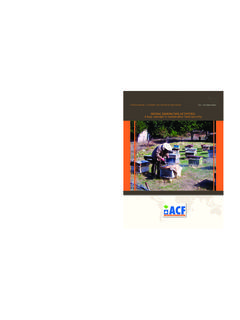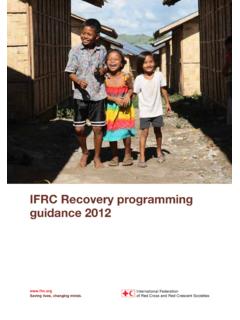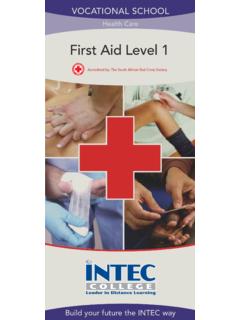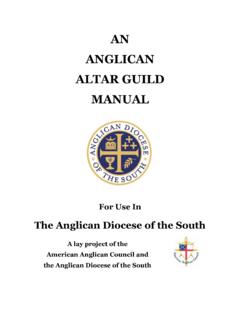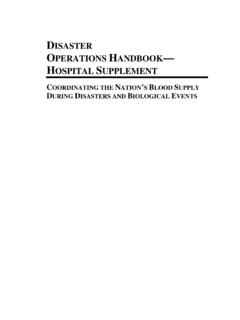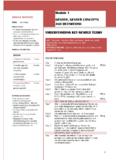Transcription of FOODSECURITYAND - Action Against Hunger
1 food security AND. LIVELIHOOD ASSESSMENTS. A PRACTICAL GUIDE FOR FIELD WORKERS. TECHNICAL DEPARTMENT OF food security AND LIVELIHOODS. ACF INTERNATIONAL. ACF food security and Livelihoods Assessment Guideline 1. April 2010. Editing: ACF International Printed: Joseph Ferruzzi Associates, Inc. Cover Photo: ACF-Uganda, courtesy P. Foley ACF International. All rights reserved 2 ACF food security and Livelihoods Assessment Guideline ACKNOWLEDGEMENTS. It is impossible to name each single person who contributed to the development of this book;. however, the methodology and examples illustrated here are a compilation of experiences from hundreds of ACF national and international staff across many ACF missions over the last ten years. Special thanks should be given to all those who have worked in the food security and Livelihood departments of ACF Headquarters and who all contributed in some way to develop the department and lay the foundation of the ACF food security and Livelihood Booklet Series.
2 This book was updated by Muriel Calo, Greg Scarborough and Lisa Troy in coordination with a peer review team consisting of Mar a Bernardez, Julien Chalimbaud, Anne-Lyse Coutin, Philippe Crahay, Adrienne Daudet, H l ne Deret, Julien Jacob, Julien Morel, Silke Pietzsch, Devrig Velly and Marie-Sophie Whitney. Case study material was provided by Abdoulaye Ilboudo (Terms of trade, ACF Burkina Faso), Abraham Afewerki (HDDS, ACF Kenya) and Geraud Devred (PRA tools, ACF Philippines). In addition the guideline was field tested in a number of ACF missions and its contents debated and discussed in the September 2009 ACF international food security and livelihood workshop in Nairobi that brought together senior FSL field staff and FSL HQ advisors. ACF food security and Livelihoods Assessment Guideline 3. 4 ACF food security and Livelihoods Assessment Guideline PREAMBLE.
3 This book is part of a series of food security and livelihood books developed by Action contre la Faim International (ACF) and is based upon a consolidation of experiences and investigations led over the past ten years in the field. This series looks at and develops specific aspects of the different food security and livelihood programs, especially the technical tools that can be used within the scope of precise projects. Each of these books can be read alone or they can be complemented and reinforced with the other ACF food security and Livelihood books included in the series constituting the food security and livelihood kit', which can be presented as follows: INTRODUCTORY TO. food security AND LIVELIHOODS: INTERVENTION PRINCIPLES. food security food Aid and Income Cash based Agriculural Assessments and Alternatives to Generating interventions Rehabilitation Surveillance food Aid Activities The books address a variety of audiences including the international humanitarian community, technical and operation field workers and the public who wishes to learn more about food security and livelihoods at the international level.
4 Each book contains a detailed index with examples of the different tools that can be used for the implementation of the programs, a glossary of technical terminology and commonly asked questions that can give the reader a quick response to key points highlighted throughout the document. This series could eventually be completed with other types of food security and livelihoods programs depending on the development and research led in the field ( , food security and livelihoods in the urban context, in the pastoral environment or other topics such as community participation or fish farming). All of these books are subject at all times to additions and or improvements following the development of the food security and livelihood departments at Action contre la Faim and the continued internal and external evaluations and evolution of the different food security and livelihood activities.
5 ACF food security and Livelihoods Assessment Guideline 5. 6 ACF food security and Livelihoods Assessment Guideline OBJECTIVE OF THE BOOK. To constitute a methodological, technical and practical reference tool for the implementation of food security and Livelihoods assessments. Contents Preamble Introduction 1. Conceptual framework 2. Gathering information 3. Sampling and assessment planning 4. Core components of a food security and livelihood assessment 5. Analyzing results 6. Identifying solutions 7. Disseminating information 8. Appendices ACF food security and Livelihoods Assessment Guideline 7. INTRODUCTION. This book is intended to provide practical guidance to ACF field workers on how to implement a food security and Livelihoods (FSL) assessment. It is intended to be used by ACF food security & livelihood project managers, team members and consultants responsible for undertaking rapid and in-depth assessments in emergency, recovery and chronic crisis contexts.
6 This guideline is a review and update of the 2006 ACF publication Methodological Approach for food security Assessments and Surveillance. Surveillance methods are not included in this book and will be covered in a separate updated module. This is the sixth book of the series and is conceived as a supporting document to the first reference book, Introduction to food security : Intervention Principles which explains the basic notions, concepts, definitions and general approaches to food security ; as well as the ACF food security & Livelihoods Policy Paper. The book sets the foundation and necessary understanding for all ACF food security and livelihood programs, introduced in the previous four books: Agricultural Program, Income Generating Activities, Cash based Interventions and Market for the Poor.
7 In addition, this book is meant to complement the SPHERE Humanitarian Charter and Minimum Standards for Disaster Response, revised in 2010. The overall conceptual approach and associated methods presented in this guideline are based on two conceptual frameworks adapted from the UNICEF causal framework for malnutrition and the DFID Sustainable Livelihoods framework. food security and livelihoods encompass a tremendously complex field underpinned by a range of factors that are in constant dynamic flux. Likewise, our understanding of how best to address a population's food insecurity and support its livelihoods in a timely, effective, locally coherent and sustainable manner changes over time. Our challenge as practitioners in the field is to adapt our conceptual approaches and related tools to reflect new insights and proven methods that ideally will have been developed in concert with affected communities and local institutions.
8 As such, this guideline represents a snapshot of our current state of knowledge but will likely require review and revision as time passes. Assessment is the second step in the project cycle. Its main purpose is to allow us to gather information on the food security and livelihoods situation of a crisis-affected population in order to identify appropriate responses by the agency. Many assessments will be carried out during various stages of an emergency (acute or chronic) in order to support programming decisions and inform the development of mid and long term strategies. Assessments will also be carried out at other stages of the project cycle, including as part of monitoring and evaluation activities and to support transition and exit strategies. To inform decisions by ACF and other actors regarding appropriate responses, assessments must answer some or all of the following key questions.
9 KEY QUESTIONS. Which crisis? What has been the impact of the crisis on the zone? On the food security and livelihoods of the population? Which groups are at risk? Where? When? Why? What types of risks do these groups face? What type of response is required to assist these groups? How much assistance is required? How much assistance is provided by other actors? How should beneficiaries be selected? How many people are in need of each type of assistance? When should the assistance be provided and for how long? What results are we seeking to obtain with our response? 8 ACF food security and Livelihoods Assessment Guideline THE STRUCTURE OF THE GUIDELINE IS AS FOLLOWS: Chapter 1. Conceptual framework This chapter lays out the broad approach to food security and livelihoods programming at ACF and the key concepts and principles that should guide the design and implementation of food security and livelihood assessments.
10 Chapter 2. Gathering information This chapter reviews the different types of food security and livelihood assessments, types of information to be gathered and broad methods for doing so. Chapter 3. Sampling This chapter looks at the main sampling approaches and provides a checklist of the key steps involved in planning an assessment. Chapter 4. Core components of a FSL assessment This chapter provides detailed guidance on the ten core elements of a food security and livelihoods assessment and suggests the use of specific tools, methods and sources of information to support the data collection. Chapter 5. Analyzing results This chapter provides an analytical framework for drawing conclusions on the assessment findings in order to judge the severity and scale of food and livelihood insecurity in the surveyed area and identify most vulnerable groups.
